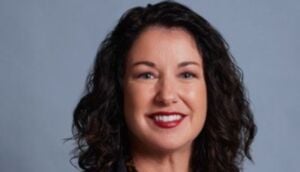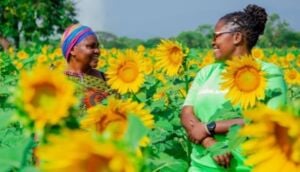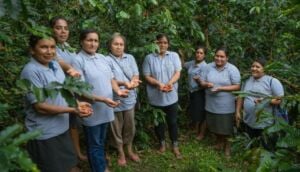The GSK and Save the Children Healthcare Innovation Award is back, do you know of an innovative solution that’s helping to save the lives of young children in developing countries? Then GSK and Save the Children want to hear about it.
A year ago in Malawi, a tiny baby was born prematurely at seven months, weighing just over 2lbs. Although Chigonjesta could breathe on his own, his lungs were so immature that it took all his energy to do so.
But with the help of a low-cost ‘bubble’ device to aid his breathing, he was able to grow and gain weight. After two weeks, he graduated to Kangaroo Mother Care – where skin-to-skin contact with his mother provided warmth and helped him regulate his breathing. Twelve months later, Chigonjesta is home and thriving with his family.
His story illustrates the impact of two innovative ideas that were recognised in last year’s GSK and Save the Children Healthcare Innovation Award. Designed to identify brilliant solutions across Africa, Asia and Latin America that are helping to save the lives of under-fives, the award aims to offer innovators the opportunity to take their great ideas to scale so they may make a difference in the lives of more young children.
When it comes to improving access to quality healthcare, no single organisation has all the answers. That means we’re always searching for new and different ideas, wherever they might be. Our award recognises that some of the best solutions to development challenges come from people living with them. Tough conditions often act as a stimulus for innovation, generating solutions that are responsive, adaptable and inexpensive. If these solutions can be shared across different countries and continents, the results can be profound. Not only could they make a difference in developing countries, but in wealthier ones too – which face their own healthcare challenges.
However, inventors often lack the opportunity to take their proven ideas to scale. By putting the resources and scale of a business like GSK behind these innovations, and the expertise and reach of Save the Children, we hope to foster great ideas and give organisations a platform from which they can share their innovation with others. Last year, we were overwhelmed by the quality and creativity of the innovations sent our way. So we are running the $1 million award again this year, seeking out other innovations that are already helping to save young lives and could do more.
Take the ‘bubble’ device developed by Friends of Sick Children, Malawi (FOSC) to help babies in respiratory distress. It costs a fraction of similar devices in developed countries; is making an impact on tackling newborn deaths; and comes with a comprehensive training and education programme. This integrated approach won FOSC a $400,000 share of the award and they are now rolling out the technology in three new countries: Tanzania, Zambia and South Africa. If implemented across the African continent, the ‘bubble’ could save 178,000 lives per year.
Kangaroo Mother Care – another of our five winners – is noted in part for its simplicity and cost-effectiveness. But it was recognised for enabling mothers to act as ‘human incubators’, which has had a positive impact on reducing mortality rates for newborn, premature and low birth-weight babies. Through the long-term efforts of the Kangaroo Foundation, the support of the Ministry of Health in Colombia and the additional boost from the award, 22 hospitals across Colombia have been trained in this system.
The visibility offered by the award, as well as the financial resources received, can help accelerate the scale-up of innovative ideas. Since winning a portion of last year’s award, ZiDi, a mobile health management system developed in Kenya, has been adopted by the Kenyan Ministry of Health. It is now working to roll out ZiDi in 5,000 public health facilities from next year, giving the innovation real reach.
What are we looking for this year? Again, we’re looking for innovations that can demonstrate results and have potential to expand. We are conscious too that innovation can take many forms – it does not exclusively mean things that need workshops or laboratories. Therefore, the criteria for the award are broad and can include approaches that focus on any aspect of healthcare, including science, nutrition, research, education or partnership working. The award winners are selected by a panel of independent health and development experts.
This year, we’re particularly searching for innovations that are helping to improve the health of newborns. The need for different approaches here is clear. Every year, almost three million babies die during the first month of life. But many of these deaths are preventable with the right resources and care in place.
Giving babies a better chance is integral to GSK and Save the Children’s partnership, which aims to help save the lives of one million children by combining our expertise, resources and influence. We are learning from each other all the time and continually push the boundaries of our partnership to deliver better results for children. Working with Save the Children has certainly made GSK think differently. For instance, it has compelled scientists to reformulate chlorhexidine, found in GSK’s mouthwash Corsodyl, to cleanse the umbilical cord stump of newborns to prevent serious infection. By thinking laterally like this, by finding other innovative approaches, we could help improve the health of even more young children. So if you know of a solution already helping to save children’s lives in developing countries – and you have the vision to take it further – we’d love to hear about it.











One Response
Development of affordable devices for developing countries is to be welcomed and there is clearly a need, as demonstrated by our own products. However as a commercial producer of Bubble CPAP designed for use in low-income countries, we have concerns about calling products developed and promoted by charitable grants “low cost” when in reality they have been heavily subsidised.
Our understanding is that the new CPAP device your article refers to was originally developed by Rice University with a substantial foundation grant. If ALL the costs, grants, donations, participants time, overheads and other resources, together with the equipment needed to make it function properly, are added up and divided by the number of CPAP products now in use, are they still “low cost” or are they actually substantially higher than the equivalent commercial product?
Our own Baby Bubble CPAP has been available for several years and is currently operating in 16 countries, including Malawi, Tanzania and Zambia. It provides safe effective CPAP in low-resource settings and has a number of additional features, such as an innovative method of increasing humidification and temperature of the gases to the baby, which is recognised by paediatricians as being an important factor in improving outcomes and saving lives.
If the aim of these funding organisations is to provide life-saving equipment to as many babies as possible in a recognised area on great need, then thought must be given to avoid the displacement of existing commercial products that are at least as equally effective. It must surely be possible to find a way forward for commercial and non-commercial organisations to work together to achieve their goals. Diamedica UK Ltd is continually carrying out research and development on related products in order to improve the outcomes for sick children and babies in low income settings.